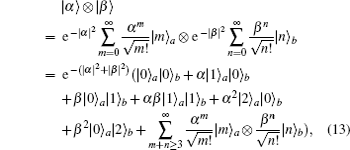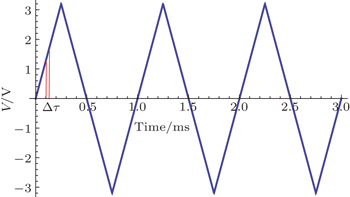† These authors contributed equally to this work and should be considered co-first authors.
‡ Corresponding author. E-mail:
Project supported by the National Basic Research Program of China (Grants Nos. 2011CBA00200 and 2011CB921200), the National Natural Science Foundation of China (Grant Nos. 61201239, 61205118, 11304397, and 61475148) and the “Strategic Priority Research Program (B)” of the Chinese Academy of Sciences (Grant No. XDB01030100 and XDB01030300).
Recently, the Hong–Ou–Mandel (HOM) interference between two independent weak coherent pulses (WCPs) has been paid much attention due to the measurement-device-independent (MDI) quantum key distribution (QKD). Using classical wave theory, articles reported before show that the visibility of this kind of HOM-type interference is ≤ 50%. In this work, we analyze this kind of interference using quantum optics, which reveals more details compared to the wave theory. Analyses confirm the maximum visibility of 50%. And we conclude that the maximum visibility of 50% comes from the two single-photon states in WCPs, without considering the noise. In the experiment, we successfully approach the visibility of 50% by using WCPs splitting from the single pico-second laser source and phase scanning. Since this kind of HOM interference is immune to slow phase fluctuations, both the realized and proposed experiment designs can provide stable ways of high-resolution optical distance detection.
For quantum information, the interference occupies the core technology. Many novel protocols and schemes rely upon high-visibility interference of photons, such as quantum cryptography,[1] quantum teleportation,[2] quantum repeaters[3] or linear optics quantum computing.[4] Interference originates from indistinguishableness. For high visibility, the interfering pulses should be indistinguishable in all possible degrees of freedom.[5–9]
The quantum key distribution (QKD) has been paid much attention since 1984.[10–13] Instead of the single-photon source, WCPs play a key role in practical QKD, based on the decoy-state technique.[14,15] Recently, measurement-device-independent (MDI) QKD, promising immunity against all detector attacks, attracts much attention[16–20] This protocol requires decoy states and phase randomization for the practical safety. Meanwhile, high visibility HOM-type interference between two WCPs is essential to the MDI QKD experiments.[16,21]
The HOM interference with independent coherent pulses is usually treated as classical interference, hence it is described in classical electromagnetic waves superposition theory[6,22,23] before. In this work, we describe this kind of interference clearly based on quantum optics, which aims to offer more details and useful information to applications like QKD. In Section 2, analysis results confirm the maximum HOM interference visibility of 50%[6] for independent WCPs. As the averaged photon number of WCPs increases, the HOM interference visibility will decrease. Moreover, we conclude that the maximum visibility of dip is contributed by the single-photon states of the two WCPs, without considering the noise. With the detector’ dark count noise (the main noise), the visibility of dip will decrease from 50% to 0 when the average photon number of WCPs is small enough. Meanwhile, the dip mainly comes from those single-photon states.
To verify the theoretical analyses, we experimentally demonstrate the HOM interference between two WCPs in Section 3. Different from MDI QKD experiments[16,21] that use two laser sources, our two interfering pulses are split from single WCP with a temporal full width of 50 ps (FWHM, full width at half maximum). To imitate the uniform phase randomization, we scan the relative phase of the interfering WCPs by applying triangular wave to the phase modulator. It is worth to mention that our phase modulation setup is designed to be polarization insensitive.[24,25] Finally, we obtain a fitting two-pulse interference visibility of 52.57%, very close to the theoretical value 50%, see Section 3. This result confirms our theoretical analyses. The two-pulse coherence time (FWHM) is 9.3 ps. Since the equivalent phase randomization is immune to slow phase fluctuations of either the phase modulator or transmission channels, our experiment setup can provide a simple and stable method of distance sensing on the level of picosecond. Furthermore, we propose a new experiment design using two Faraday mirrors. This design avoids using any active phase modulation and polarization control, and it promises higher resolution.
Figure

It is the essence of the two-pulse interference that the detectors can not distinguish the two cases above. To demonstrate this viewpoint, we will depict the two-pulse interference progress with the creation and annihilation operators.
Before reaching BS, the initial state can be expressed as
















Since the formulation of E1 is complex, here we give some numerical integrations. As depicted in Fig. dip versus the detection efficiencies. |α|2 = |β|2 = 1. dip versus the average photon number |α|2 = |β|2. η1 = η2 = 10%.
Now we prove that the maximum visibility of 50% comes from the two-photon HOM interference. In terms of the number state, the initial state of the two interfering WCPs can also be expressed as



With |α|2 = |β|2, we have




For briefness and highlighting the emphasis, the analyses above do not consider the noise, which is mainly caused by the dark counts of the single photon detectors in our experiment. We can easily obtain the result considering the dark-count noise, by adding the dark count probability to the probability of one click in c (or d) port. With the dark count probability of 10−6 (one typical value for the 1550-nm detectors), we did some numerical simulations similar to those in Figs.
Our experimental setup is shown in Fig. The HOM interference experimental setup. The laser: 1550 nm, temporal duration time of 50 ps (FWHM). OD: optical delayers, Newport Corp. FM: Faraday mirror. PM: phase modulator. PC: polarization controller. PBS: fiber polarization beam splitter. D1, D2, and D3: single photon detectors with gate width of 1 ns. The coincidence counts are detected by D1 and D2. And their detection efficiencies are 15% and 16% respectively.
We use the PM to introduce the extra relative phase between the two interfering WCPs. The phase modulation setup, composed of FM, PM, and circulator, is polarization-insensitive.[24–26] Since the FM can passively compensate the polarization, polarization mode dispersion, and polarization-dependent loss.[24] For easy demonstration, we apply the triangular voltage wave to the PM to introduce uniform phase distribution within 0 ∼ 2π, rather than random uniform phase distribution. If we only concern the HOM interference visibility, the phase randomization is not necessary, see Eqs. (
For uniform phase distribution, there are two important points that should be satisfied. First, one phase scanning period should be much larger than the optical pulse repetition period. In our experiment, the frequency of the triangle wave is 1 kHz, as depicted in Fig.
To avoid active phase modulation and polarization control, we propose another design of setup as depicted in Fig. The new design of experiment. L: a positive integer. 1-bit delay equals one period of the pulse repetition of the laser.
It is worth to mention that our experiment setup and the new design (especially) can tolerate slow phase fluctuations during transmissions. This provides simple and stable methods of high-resolution distance sensing, where the resolution is determined by the coherence time of the interfering WCPs.
In this work, based on quantum optics, we give detailed analyses on the HOM interference between two independent coherent pulses. Analysis results confirm that the maximum interference visibility of two independent WCPs is 50%. Additionally, we conclude that the maximum visibility of 50% comes from the single-photon states of WCPs, without considering the noise.
The experiment result supports the theoretical analyses. And we propose simple and stable designs to achieve the HOM interference of WCPs. Since the HOM interference of WCPs is immune to slow phase fluctuations, our designs can provide stable ways to achieve the high-resolution distance sensing. For example, in the experiment, the coherence time of the two interfering WCPs is only 9.34 ps, which can provide a resolution on the level of ps.
We believe our work will offer helpful guidance about the interference between two independent coherent states.
| 1 | |
| 2 | |
| 3 | |
| 4 | |
| 5 | |
| 6 | |
| 7 | |
| 8 | |
| 9 | |
| 10 | |
| 11 | |
| 12 | |
| 13 | |
| 14 | |
| 15 | |
| 16 | |
| 17 | |
| 18 | |
| 19 | |
| 20 | |
| 21 | |
| 22 | |
| 23 | |
| 24 | |
| 25 | |
| 26 |






